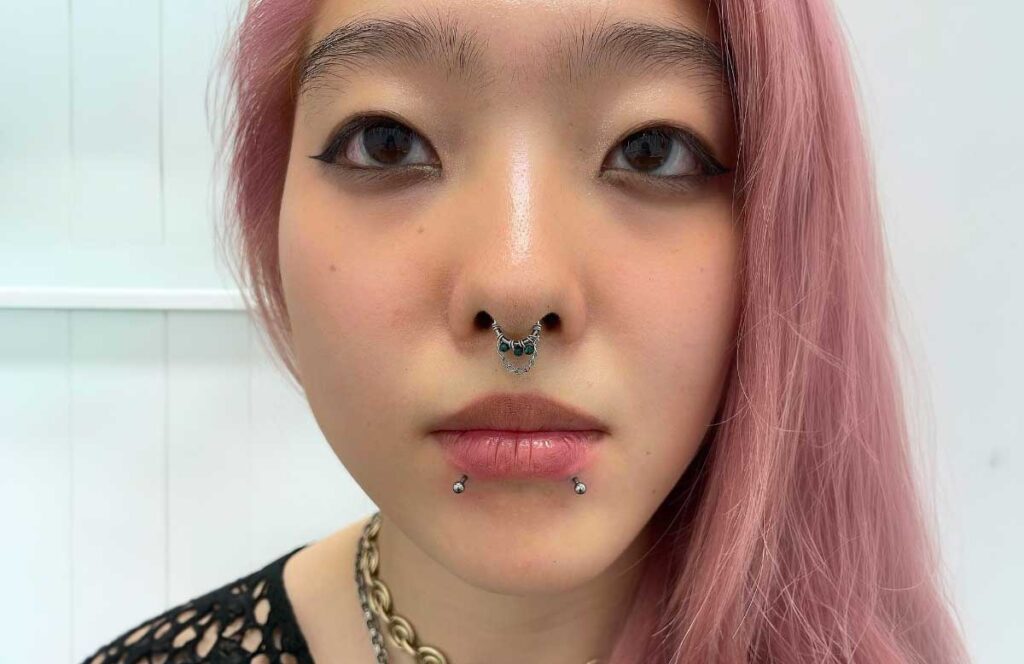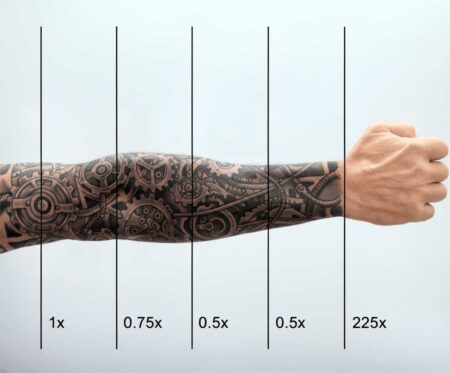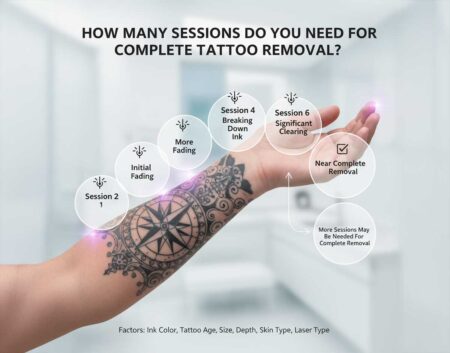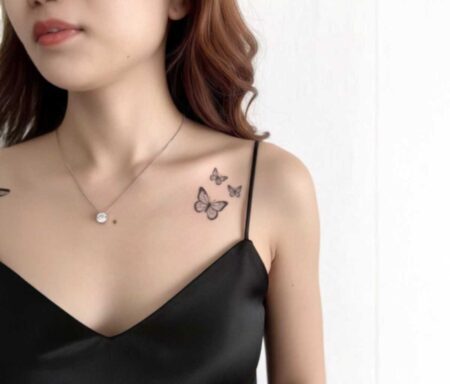Thinking of getting snake bites piercings? Before taking the plunge, make sure you know what you’re getting into! This edgy piercing option can be super stylish, but you gotta be prepared for the pain, healing time, risks, and proper aftercare.
In this guide, we walk through everything you need to know about snake bites. We’ll look at how the piercing is done, just how much it hurts, the healing timeline, plus aftercare do’s and don’t’s. We’ll also chat about potential risks like tooth damage or scarring. And you’ll learn about different snake bite jewelry options and costs too.
So if you’re considering some venomous new fang piercings, read on for snake bite facts from pain levels to appropriate jewelry. Let’s slither into it!
What Are Snake Bite Piercings?

Snake bites piercings are a type of lip piercing located on both sides of the lower lip. As the name implies, this piercing style resembles the fangs of a snake.
Snake bites piercings consist of two lip piercings placed symmetrically on opposite sides of the lower lip. Typically, snake bites contain labret studs or rings, with one piercing on each side. However, some variations include a single snake bite with just one lip piercing, or vampire bite piercings on the top lip.
This piercing originated in the punk rock and hip hop subcultures of the 1980s and 1990s. It became associated with rebellion, edginess, and self-expression. Over the years, snake bites piercings gained mainstream popularity. They remain an eye-catching facial piercing option for those seeking a bold, alternative look.
Some key facts about snake bites piercings:
- Also referred to as venom bites or fang piercings
- Pierced using 14 or 16 gauge needle
- Healing time of 1-3 months
- Requires diligent aftercare while healing
- Risks include swelling, scarring, gum/tooth damage
Snake bites allow creative self-expression through the endless jewelry options the two piercings provide. However, it’s also an intimate piercing with risks worth considering before getting pierced.
Wondering what cute face jewelry would look best on your facial features? Click through to our guide on the most flattering face piercing ideas for YOUR unique face shape!
Pain and Healing Time
So how long is it gonna take your new snake bites piercings to heal up? Get ready for about 2-3 months of healing, my friend. But it really depends how closely you stick to the aftercare routine.
Getting snake bites piercings will inevitably involve some pain and significant aftercare. Here’s an overview of what to expect:
The Piercing Procedure
Reputable piercers use sterile needles between 14-16 gauge in size to perform snake bites piercings. The needle quickly punctures the lip, generally feeling similar to getting blood drawn.
Some lingering soreness, swelling, and tenderness typically lasts for a few days after the initial piercing. Pain levels vary greatly depending on personal pain tolerance, but most report snake bites as moderately painful.
Healing Timeframe
On average, snake bites piercings take 2-3 months to fully heal. During this time, the following care is crucial:
- Cleaning – Gently clean piercings 1-2 times daily using saline solution or saltwater. Rinse after eating/drinking.
- Avoid irritation – Refrain from playing with jewelry, smoking, excessive talking, or using makeup.
- Oral hygiene – Brush teeth gently and use non-alcoholic mouthwash.
Signs of normal healing include some bleeding, swelling, and discharge during the first week. With proper aftercare, inflammation should subside after a few weeks.
Potential Healing Issues
Without diligent cleaning, snake bites piercings risk developing:
- Bacterial infections – Characterized by redness, swelling, pus, and fever requiring antibiotics.
- Abscesses – Accumulation of pus and tissue swelling, needing prompt medical drainage.
- Migration or rejection – Pierce hole migrates, potentially rejecting and scarring.
See your piercer promptly for any signs of complication to get appropriate treatment. With attentive aftercare, snake bites generally heal smoothly within 12 weeks.
Aftercare

Caring for new snake bites piercings is crucial during the initial healing phase. Follow these aftercare guidelines:
- Cleaning – Gently clean piercings 1-2 times per day using a saline spray or saltwater solution. Rinse mouth with water after eating and drinking.
- Jewelry – Avoid changing jewelry for at least 6-8 weeks until fully healed. Initially use medical-grade titanium or steel jewelry.
- Oral hygiene – Brush teeth gently after meals using a soft brush. Use alcohol-free mouthwash.
- Avoid irritants – Refrain from smoking, excessive talking, playing with jewelry, or using makeup around piercings.
- Touching – Only touch piercings when necessary to minimize bacteria transfer. Wash hands before contact.
- Sleeping – Use a travel pillow and sleep on your back to avoid irritation.
- Infection – Watch for signs like swelling, pus, redness, fever indicating infection. Seek medical help promptly.
With consistent, thorough cleaning and avoiding irritation, snake bites should heal well within a couple months. Then less intensive aftercare is needed long-term.
Possible Piercing Side Effects

While snake bites piercings pose less risks than oral piercings, complications can potentially occur:
- Swelling – Significant swelling and tenderness is common for the first week. Prolonged swelling could indicate infection.
- Scarring – Scarring may occur if piercings reject or migrate. Hypertrophic scarring is also possible.
- Gum/tooth damage – Piercings can gradually recede gums or crack tooth enamel. Keep jewelry shorter to reduce rubbing.
- Nerve damage – The mental nerve may rarely be affected, causing lip numbness that requires jewelry removal.
- Chipped teeth – Rings or oversized studs increase risk of chipping teeth, especially when eating or talking.
- Recession – Pressure from longer jewelry can cause gum recession over time.
To minimize risks, have an experienced piercer place snake bites slightly farther back on the lips. Avoid jewelry that’s excessively long or rigid during initial healing. Most side effects resolve once piercings fully heal or jewelry is removed.
Changing Out the Piercing
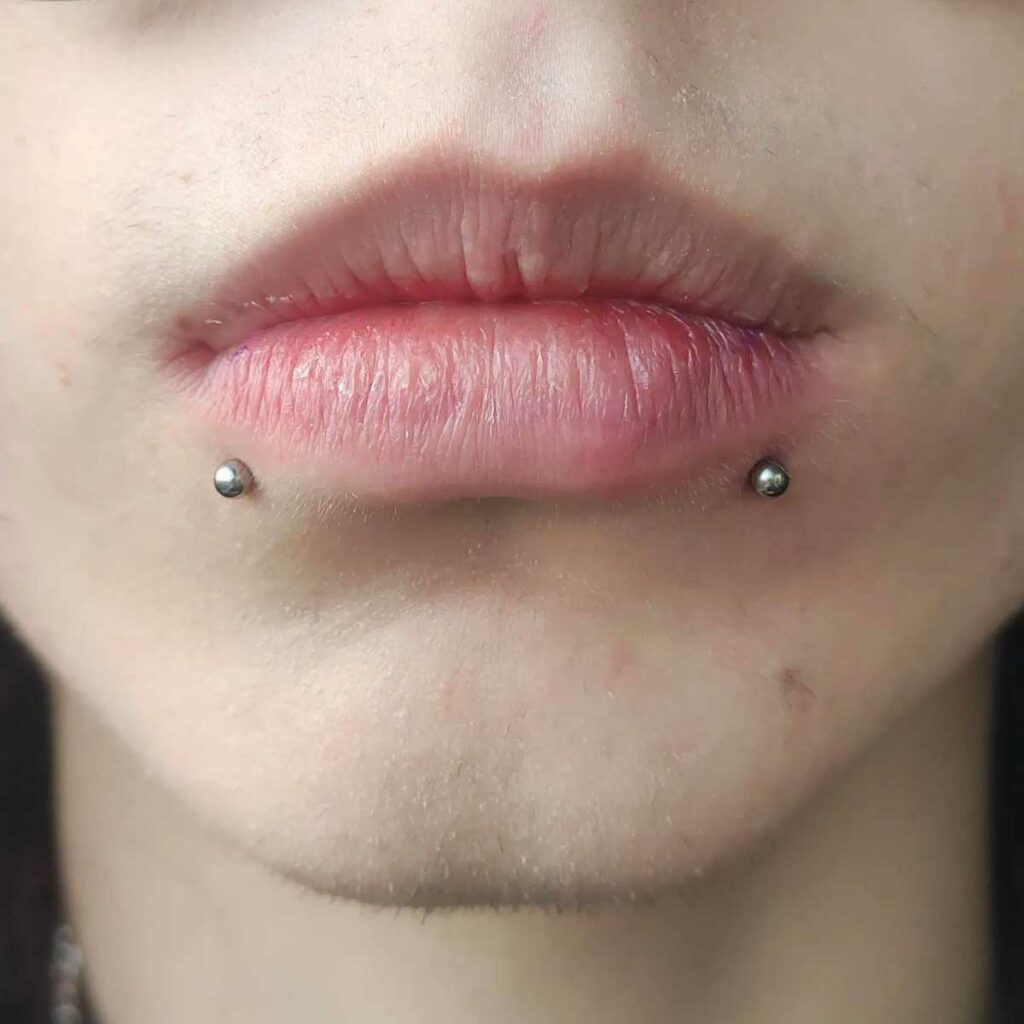
Once snake bites piercings fully heal after 1-3 months, you can start changing out the original jewelry. Here’s what to know:
- Wait the full healing timeframe before switching jewelry to avoid complications.
- Wash hands thoroughly before handling piercings. Sterilize new jewelry by soaking it in rubbing alcohol.
- Carefully insert new jewelry using a mirror to guide placement. Avoid forcing it.
- Initially opt for high-quality titanium or steel jewelry that won’t irritate piercings.
- Once healed for 6+ months, you can try alternative metals like gold or platinum.
- Rings, hoops, and studs in various sizes and colors allow customization.
- Have piercer change jewelry initially if unsure about sizing and placement.
- Schedule annual checkups with piercer to assess placement and condition.
- If removing jewelry, piercings may close within hours so replace promptly if desired.
With proper hygiene and care, changing snake bites jewelry can be done safely yourself once fully healed. This allows you to customize your look over time.
Types of Jewelry and Materials

Snake bites piercings have various jewelry options to achieve your desired look:
Types of Jewelry
- Labret studs – Straight posts with flat backing. Most common initial jewelry.
- Captive bead rings – Circular rings with ball that screws into place.
- Barbells – Straight bar with balls on each end. Allow more swelling.
- Circular barbells – Round rings with balls that twist off.
- Lip rings/hoops – Circular hoop rings. Not ideal for initial piercings.
Jewelry Materials
- Surgical steel – Most affordable, nickel-free option. Can irritate sensitive skin.
- Titanium – More expensive, but very hypoallergenic. Best for initial piercings.
- Niobium – Also hypoallergenic. More rare and costly.
- 14+ karat gold – Higher karat is more pure with less reactions.
- Platinum – Most expensive. Inert metal with very low reactivity.
Avoid cheap jewelry containing nickel or lead which provoke allergic reactions. Work closely with your piercer to select initial jewelry material ideal for your skin.
If you’re tempted to try the trending snake eyes piercing, hold that thought! This wild tongue jewelry takes some serious commitment. Our guide covers everything you need to know before splitting your tongue.
How Much Does the Snake Bites Piercing Cost?

The costs of getting snake bites piercings include:
- Piercing fee – Typically $60-$120 per piercing. Based on piercing shop and experience of the piercer.
- Initial jewelry – Studs or rings often around $10-$100 per piece. Titanium is more expensive.
- Ongoing jewelry – New jewelry after healing can range widely in cost depending on metals and stones.
- Tip – It’s customary to tip your piercer ~10-20% of total piercing cost.
Additional factors affecting price:
- Body region – Oral piercings like snake bites cost more than ear lobes.
- Shop location – Urban shops in high-demand areas charge more.
- Jewelry quality – High-end metals, customized pieces, or gemstones cost more.
- Extensive portfolio – Renowned piercers with long experience warrant higher pricing.
So in total, expect to invest $100-$200 to have snake bites done properly, including two studs or rings. Price varies greatly based on the above factors.
Snake Bite Variations

While traditional snake bites are placed symmetrically on both sides of the lower lip, some unique variations include:
- Single snake bite – Just one labret stud on one side of the lower lip.
- Double snake bites – Instead of one, two studs are placed on each side of the lower lip for a total of four piercings.
- Vertical labrets – Studs placed vertically on the upper and lower lip on each side.
- Cyber bites – One labret stud on the lower lip paired with a medial labret piercing in the center.
- Jestrum piercing – Vertical labret with top piercing inside the upper lip rather than outside.
- Dolphin bites – Two labret studs on lower lip and one in center on upper lip.
- Spider bites – One labret stud on opposite sides of the lower lip, but not directly across.
- Snake eyes – One curved barbell shaped like a horseshoe goes through both sides of the lower lip.
The options are endless for customizing your snake bites piercing configuration and symmetry. Discuss your preferences with an experienced piercer.
Click through now to get the insider info on industrial piercings – including things to avoid and expect during the healing process. Let’s do this right!
What to Know Before Getting Snake Bites

Snake bites piercings allow creative self-expression, but consider these factors beforehand:
- Find an accredited piercer with extensive experience performing oral piercings. Verify they follow sanitization best practices.
- Be prepared for significant swelling, soreness, and tenderness for the first week. Discomfort while eating and talking will also occur initially.
- Snake bites pose moderate risks of gum recession, chipped teeth, and scarring if jewelry is improper or aftercare is insufficient.
- Jobs requiring strict dress codes or food service may prohibit lip piercings due to hygiene concerns.
- The piercing site will be sensitive for a few months. Refrain from vigorous sports and activities during healing.
- You may temporarily have a lisp while tongue adjusts to the new piercings. This typically resolves within a couple weeks.
- Consistently follow your piercer’s aftercare instructions to minimize risks of infection or other complications.
For many, the edgy style of snake bites piercings is worth the commitment of proper aftercare and potential tooth/gum risks. But fully consider the implications beforehand.
FAQs

Does getting the piercing hurt?
The piercing procedure itself is moderately painful, feeling like a quick pinch. It usually hurts less than cartilage or nose piercings. Significant soreness and swelling follows for the first week.
How long until I can change the jewelry?
Wait at least 6-8 weeks until snake bites are fully healed before changing jewelry to avoid complications. See your piercer for initial jewelry changes.
Can snake bites damage my gums or teeth?
There is a risk of gradually receding gums or chipping teeth if jewelry is too tight or long-term aftercare is insufficient. Proper placement and length by an experienced piercer reduces this risk.
How long will it take to heal?
On average, snake bites piercings take 1-3 months to fully heal. With consistent aftercare, swelling and tenderness improves after the first week.
Will snake bites leave visible scars if I remove them?
Some minimal scarring is likely over time as the piercing hole closes. But scars tend to fade and aren’t highly visible due to the lip’s moist environment.
Can I still apply lip products or chapstick?
Avoid wearing makeup, lipstick, or balm until snake bites have fully healed. After healing, gently apply products without getting them into the piercing hole.
Will snake bites change my speech or leave me with a lisp?
Temporary lisp or slurring is common initially as your tongue and lips adjust. But this typically resolves within 2-4 weeks.
The Bottom Line
For those seeking a bold, edgy facial piercing, snake bites present a stylish option. With proper placement and high-quality jewelry, they can be an expressive addition to your look.
However, adequate aftercare is crucial during the 1-3 month healing period to avoid complications like infections or scarring. There are also risks of potential gum recession, chipped teeth, or speech changes to consider.
Be sure to pick an extremely reputable piercer with a portfolio demonstrating experience with oral piercings. They can advise on ideal placement and jewelry to minimize damage or rejection risks.
Snake bites require diligent cleaning, oral hygiene, and avoiding irritants while healing. Once healed, you can admire your new edgy piercings with proper care.
For many, the punk rock style and self-expression snake bites allow outweighs the commitment to aftercare. If you can accept the risks and required upkeep, snake bites piercings can give you a bold, customized lip piercing look.
We hope this guide gave you a comprehensive overview of snake bites piercings!
Getting snake bites is a big commitment – from the piercing pain itself to diligent aftercare. There are also risks to consider that come with any lip or oral piercing.
If you’re thinking about getting snake bites or already have them, we’d love to hear your thoughts and experiences!
Leave a comment below to share your snake bites story. Do you love your edgy new look or have any regrets? How was your healing process? Feel free to ask any additional questions you may have too.
We try our best to cover every useful detail and answer common questions in this guide. But nothing beats first-hand experiences from our readers.
So don’t be shy! Let us and others benefit from your snake bites wisdom by writing a quick comment below.


